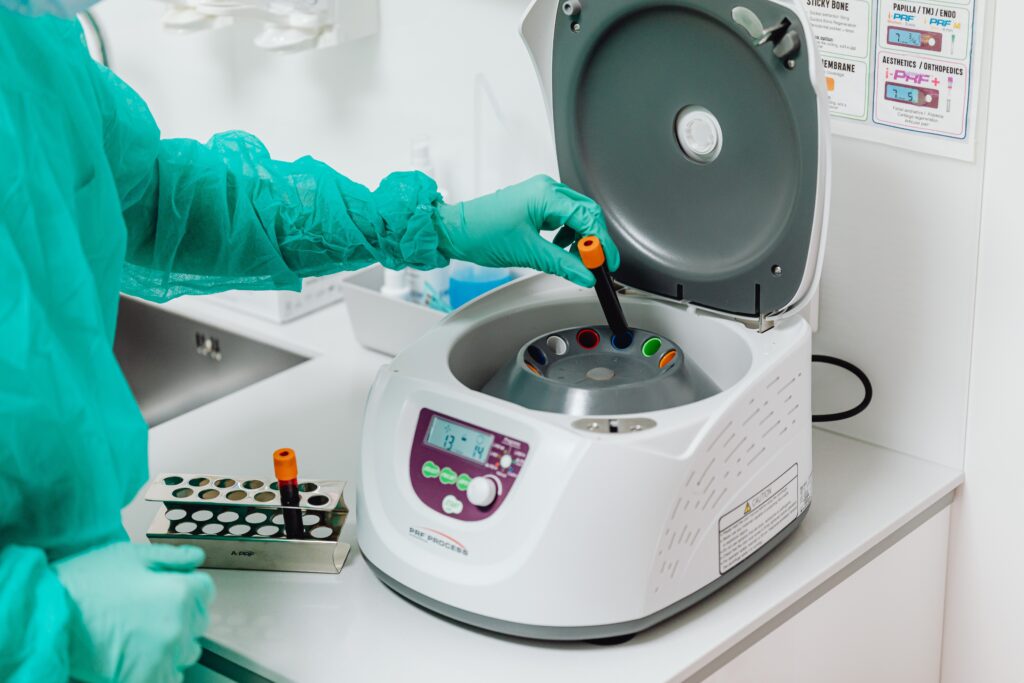Centrifugation Principles: Centrifugation Types, Applications, and Examples
What Is Centrifugation?

Centrifugation techniques are integral to scientific research because they can separate and purify substances based on their physical properties.
Parts of a Centrifuge
A centrifuge has three main components:
- Rotor: The rotor fixes the tubes containing the centrifuged material in place. Rotors can come in different shapes and sizes depending on the intended components of interest. They must be loaded onto the centrifuge in a balanced position, otherwise risking the machine failing.
- Driveshaft: The drive shaft affixes the motor to the rotor.
- Motor: The motor is responsible for the spin of the centrifuge.

Principles of Centrifugation
Many principles govern the mechanics of centrifugation, but the primary is centrifugal force. Centrifugal force is an outward push experienced during high-speed rotation, acting radially from the center of rotation and causing the movement and sedimentation of particles suspended in a sample.
Centrifugal Force and Sedimentation
Caused by centrifugal force, sedimentation is the process by which denser particles settle at the bottom of a sample tube inside a centrifuge. The sedimentation rate is determined by the particles’ size, shape, and density, with heavier and more dense particles moving faster.
Differential sedimentation depends on the varied sedimentation rates of particles through a fluid.
Sedimentation Rate and Pellet Formation
During rapid centrifugation, particles will sediment into a pellet at the base of the tube or container. This pellet is composed of heavy and dense particles suspended in the sample and can be easily separated for direct analysis after centrifugation.
Other Factors Involved in Centrifugation
Another principle at work during centrifugation is buoyancy which is influenced by the medium in which the particles are suspended. Speed and time of centrifugation are also crucial factors to consider in experimental design, as increasing centrifugation’s duration and speed increases the extent of separation. These factors can be determined for the optimal separation of desired particles or components of interest. The rotors’ size and tubes can also impact efficiency and performance.
Centrifugation Techniques
Centrifugation allows for separating components based on physical properties and can be used in various applications and formats.
Differential Centrifugation
Differential centrifugation utilizes multiple rounds of centrifugation at progressively higher speeds to separate components based on size and density. This allows for the separation of organelles and other cell components.
Differential centrifugation can have several steps, depending on the level of separation desired. For example, differential centrifugation can begin with a low-speed initial spin step. This slower spin allows debris, contaminants, whole cells, nuclei, and cell membranes to pellet, leaving a purified centrifugation supernatant. This supernatant proceeds to a second spin step, this time at a higher speed, called the medium speed step. The pellet that forms during this step is composed of organelles and the consequent supernatant contains the remaining small particles, proteins, and nucleic acids.
In this example, the supernatant from the medium-speed step undergoes a final spin at the highest speed. This ensures the separation of small ribosomal and viral particles along with proteins and nucleic acids. After centrifugation, the tubes from each step of the process can be divided into several fractions, each containing particles with similar densities for further analysis and processing.
Density Gradient Centrifugation
Density-gradient centrifugation is an essential tool that allows for separating and defining the relative density of particles in a sample using a gradient of known density. A density gradient is created within a centrifuge vessel by layering solutions by known density. Compound CsCl is commonly used in this application to prepare a gradient.
The sample of unknown density is loaded onto the density gradient and centrifuged at a high speed until the particles migrate to their equilibrium positions. These positions align with the density of the particles themselves. This technique is especially useful in separating DNA, RNA, proteins, and nucleic acids, as buoyant density plays an important role in their response to the gradient.
Ultracentrifugation
Ultracentrifugation provides maximum separation power and precision using high rotation speed and specialized rotors. Commonly used to separate macromolecules and subcell components, there are two main types of ultracentrifugation: analytical and preparative.
Analytical Ultracentrifugation
This is a technique used to study the hydrodynamic properties of small molecules, such as DNA. Analytical ultracentrifugation involves subjecting samples to high speeds and monitoring the reactions based on sedimentation velocity and equilibrium factors.
Preparative Ultracentrifugation
Ideal for large-scale research, preparative ultracentrifugation purifies small molecules like DNA and proteins at high speed using unique rotors. This high-speed ultracentrifugation results in a pellet of dense particles.
What Is Counterflow Centrifugation?
Also known as countercurrent centrifugation, counterflow centrifugation is a specialized technique that allows for the continuous separation of components based on density. Counterflow centrifugation differs from conventional centrifugation by sample and separation medium introduction and collection. In counterflow centrifugation, the sample and medium are introduced to opposing ends of the rotor and flow in opposite directions. The flow causes the components to separate based on density.
The sample is introduced to the rotor through a feeding tube and mixed with a separation medium to create a density gradient. The buffer or separation medium, generally composed of sucrose, is fed through the other end of the rotor. As the two products flow opposite each other, the particles migrate through the separation medium according to buoyant density. Heavier particles will move more quickly against the current, while lighter particles are swept up in the current. This design allows for the continuous flow of separation. The sample and medium will collect at their opposite ends for separate collection.
Counterflow centrifugation enables continuous separation and collection of components (as opposed to collection layers or pellets as required in conventional methods). Counterflow centrifugation is an essential tool for many research initiatives in cell separation, isolation, and purification.
Counterflow centrifugation is also integral for large-scale research and cell manufacturing demand. Because of counterflow centrifugation’s continuous separation abilities, there is no need to stop the function between separation steps, which saves time and increases efficiency by providing an uninterrupted process. The size of rotor adaptors can be modified—as can the separation medium—to accommodate large sample sizes and high volumes continuously.
Significant automation potential exists for counterflow centrifugation methods, promising an answer to the high volume and throughput required in large-scale research projects. Automated systems provide ease and efficiency, reducing manual labor and human error. The most common counterflow centrifugation automation is an automated cell washing instrument such as the Thermo Fisher Scientific CTS Rotea Counterflow Centrifugation System or the Cytiva Sepax Cell Processing System, designed to wash and process cells in clinical settings. These automated cell washers effectively remove unwanted substances and contaminants from samples.

New Centrifugation Products From Akadeum
Centrifugation techniques like density gradients and differential centrifugation are critical in multiple scientific disciplines. These tools allow researchers to separate components based on size and density.
The automation advancements of centrifugation techniques have revolutionized large-scale cell therapy research and clinical fields,
Learn more about this exciting news and how our revolutionary microbubbles work with centrifugation by contacting Akadeum to streamline your workflow and improve efficiency!


